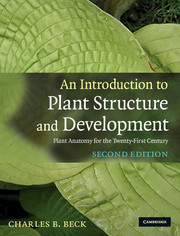Book contents
- Frontmatter
- Contents
- Preface to the second edition
- Preface
- Acknowledgements
- General references
- Chapter 1 Problems of adaptation to a terrestrial environment
- Chapter 2 An overview of plant structure and development
- Chapter 3 The protoplast of the eukaryotic cell
- Chapter 4 Structure and development of the cell wall
- Chapter 5 Meristems of the shoot and their role in plant growth and development
- Chapter 6 Morphology and development of the primary vascular system of the stem
- Chapter 7 Sympodial systems and patterns of nodal anatomy
- Chapter 8 The epidermis
- Chapter 9 The origin of secondary tissue systems and the effect of their formation on the primary body in seed plants
- Chapter 10 The vascular cambium: structure and function
- Chapter 11 Secondary xylem
- Chapter 12 The phloem
- Chapter 13 Periderm, rhytidome, and the nature of bark
- Chapter 14 Unusual features of structure and development in stems and roots
- Chapter 15 Secretion in plants
- Chapter 16 The root
- Chapter 17 The leaf
- Chapter 18 Reproduction and the origin of the sporophyte
- Glossary
- Index
- References
Chapter 13 - Periderm, rhytidome, and the nature of bark
Published online by Cambridge University Press: 05 June 2012
- Frontmatter
- Contents
- Preface to the second edition
- Preface
- Acknowledgements
- General references
- Chapter 1 Problems of adaptation to a terrestrial environment
- Chapter 2 An overview of plant structure and development
- Chapter 3 The protoplast of the eukaryotic cell
- Chapter 4 Structure and development of the cell wall
- Chapter 5 Meristems of the shoot and their role in plant growth and development
- Chapter 6 Morphology and development of the primary vascular system of the stem
- Chapter 7 Sympodial systems and patterns of nodal anatomy
- Chapter 8 The epidermis
- Chapter 9 The origin of secondary tissue systems and the effect of their formation on the primary body in seed plants
- Chapter 10 The vascular cambium: structure and function
- Chapter 11 Secondary xylem
- Chapter 12 The phloem
- Chapter 13 Periderm, rhytidome, and the nature of bark
- Chapter 14 Unusual features of structure and development in stems and roots
- Chapter 15 Secretion in plants
- Chapter 16 The root
- Chapter 17 The leaf
- Chapter 18 Reproduction and the origin of the sporophyte
- Glossary
- Index
- References
Summary
Perspective
Except in the very youngest regions, the stems and roots of woody plants (specifically, gymnosperms and dicotyledons) are covered by bark consisting of the functional secondary phloem and rhytidome, a complex tissue comprised of successively formed periderms, often of overlapping shell-like morphology, between which are enclosed dead cortical and/or phloem tissues. The outer covering of stems of large monocotyledons differs from that of woody dicotyledons and will be discussed later. The outer bark of woody dicotyledons, consisting primarily of rhytidome, is a protective layer which restricts entrance of both insects and microorganisms and also protects the inner living tissues from temperature extremes. It also inhibits water loss through evaporation, but at the same time allows gaseous exchange through specialized regions in the periderm called lenticels. In addition it supplements the secondary xylem in stiffening young stems (Niklas, 1999), thus contributing to their ability to withstand the bending forces exerted by excessive wind and/or the weight of ice.
Periderm: structure and development
Periderm consists of phellem and phelloderm, both derived from a single-layered secondary meristem, the phellogen (Fig. 13.1a, b). Cells of the phellogen are tabular, radially thin, somewhat elongate, and polygonal as viewed tangentially. In many plants the phellogen forms at about the same level in the stem and at about the same time as the vascular cambium. The site of its initiation is highly variable but often is an outer layer of cortical parenchyma one or two layers beneath the epidermis (Fig. 13.1b).
- Type
- Chapter
- Information
- An Introduction to Plant Structure and DevelopmentPlant Anatomy for the Twenty-First Century, pp. 247 - 254Publisher: Cambridge University PressPrint publication year: 2010

